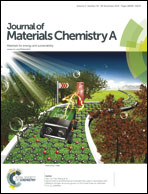Inkjet-printed highly conductive transparent patterns with water based Ag-doped graphene†
Abstract
Inkjet-printing-based fabrication has been a promising approach with the rapid development and deployment of new material inks. Previous studies have demonstrated inkjet printing of reduced graphene oxide (rGO) or pristine graphene flakes produced by the liquid phase exfoliation method for various devices. Nevertheless, it is still a challenge to inkjet-print conductive patterns with a metal and graphene-based hybrid ink, and to explore the structure effect of metal nanoparticles on the conductivity of graphene-based transparent patterns. Herein, we present a holistic approach to achieve high-performance printed Ag nanotriangle platelet–rGO (Ag NTP–rGO) and Ag polyhedral nanoparticle–rGO (Ag NP–rGO) patterns that addresses the entire process starting from graphene oxide exfoliation, ink formation, printing, to final reduction. Central to this approach is that the solvent of inks is only water, monodisperse Ag nanotriangle platelets (Ag NTPs) and Ag polyhedral nanoparticles (Ag NPs) can be self-assembled on GO which is also used as a dispersant and a stabilizer, and after reduction, compared with rGO, Ag NP–rGO and other rGO-based materials previously reported, the Ag NTP–rGO pattern displays a low sheet resistance of 170 Ω □−1 with a transmittance of 90.2%. This inkjet-printed and reduction process can be broadened to obtain other metal–graphene patterns and devices.


 Please wait while we load your content...
Please wait while we load your content...